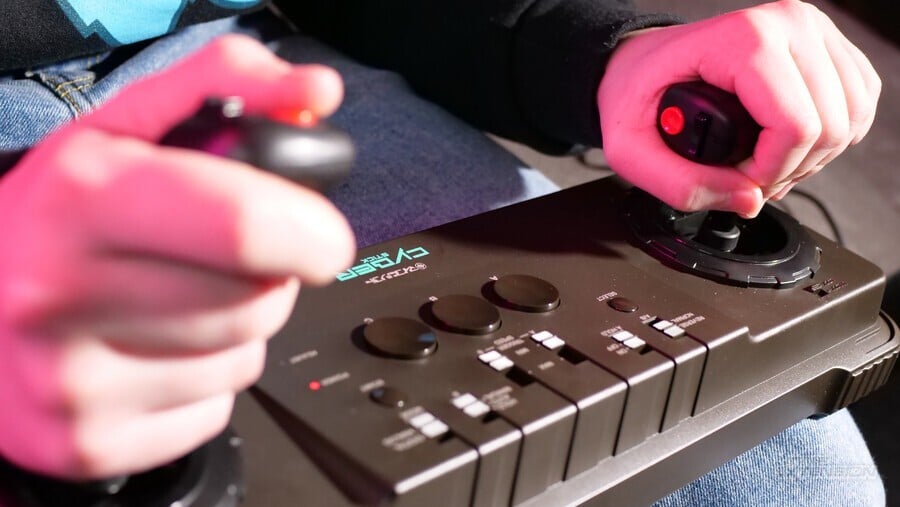
The fact that Sega's Genesis / Mega Drive Mini II ships with all-new versions of Space Harrier and Fantasy Zone wasn't the only pleasant surprise which accompanied the arrival of the micro-console – Sega also revealed that the machine would be accompanied by a ¥19,800 / $150 / £125 analogue flight stick controller which costs even more than the base system – and that it would be exclusive to Japan.
It's worth digging into the history of this rather unusual controller because, as random as it seems, there's a method to Sega's madness here. Initially intended for use on the Sharp X68000 series of Japanese home computers, the original 1990 Cyber Stick was manufactured by Sharp (under the name CZ-8NJ2) and Micomsoft (designated XE-1AJ, notable for its orange A, B and C buttons) and offered analogue control at a time when this was a relative novelty, at least outside of the arcades.
The Cyber Stick was compatible with the PC98 and FM Towns home computers, too, but it was support for other systems that really raised eyebrows. After Burner II, a relatively early 1990 release for the 16-bit Mega Drive console, featured compatibility with the stick (if you created a special adapter) thanks to the fact it supported the technically-similar XE-1AP analogue joypad. This delivered an experience that took players even closer to the arcade original, thanks to the inclusion of analogue control and a throttle. Sadly, precious few got to play the game with the Cyber Stick – but that's something that this new, USB-based variant will hopefully fix, even if it's only by a small degree.
The 2022 Cyber Stick looks like a close match to the original – we say 'looks' because we've never actually tried the original version. The obvious points of interest are the analogue control stick and the throttle control, which sit on either side of three main action buttons, 'Start' and 'Select' keys and a bunch of other switches and toggles. The base of the controller is made of metal, so it has a pleasant amount of heft to it – very much like any arcade fighting stick you'd buy.
The analogue stick and throttle are actually interchangeable; there's a switch above each one which unlocks a mechanism that allows you to rotate and then lift out the stick. Carefully detach the wiring (watch out for the hot glue!), and you can swap their positions – handy for left-handed people or those who simply prefer the controls to be reversed, for whatever reason.
These are decent controls, too. The analogue stick snaps back to the middle when you release it, and it feels like a close match to the original After Burner arcade controls. The buttons are nice and clicky, but they make a lot of noise when pressed repeatedly. One major negative is the fact that the USB lead is relatively short, so you'll need to sit close to your Mega Drive Mini II during use (coincidentally, the Cyber Stick must be plugged into the second controller port of the machine in order to function fully – plugging it into port one means analogue control isn't available, only digital).
After Burner II is naturally the game which is going to be of most appeal to anyone who purchases a Cyber Stick, and it really is the best way to experience the game; while the Mega Drive port isn't arcade perfect, it certainly feels closer to the coin-op when you're brandishing this stick due to the more precise analogue control and the ability to control your aircraft's speed more effectively using the throttle. Taito's Night Striker, Namco's Star Blade and the all-new port of Space Harrier also support the Cyber Stick, and all play wonderfully as a result. We certainly can't fault the controller in terms of achieving its aim; it really does improve the games that it's designed to function with.
The issue is that these are just a handful of the 60 titles included on the Mega Drive Mini 2. While it can also be used as a digital controller, you're much better off using the standard controller for non-analogue games – which means the large and bulky Cyber Stick isn't going to get much use, unless you're a certified After Burner addict.
To counterbalance this, it's worth noting that the Cyber Stick is compatible with other USB devices, including your desktop PC, so you might find you get unexpected additional mileage away from the Mega Drive Mini II. Sega makes a point of saying that the controller isn't compatible with the original X68000 – but, with a 'mini' version of that on the way too, we could see it provide a means to experience some of that system's best titles.
Given its high price, meagre selection of compatible games and Japanese exclusivity (we should point out that it doesn't matter which region of the Mega Drive Mini II you have, it works across all of them), the Cyber Stick is likely to be a luxury most casual Sega fans will ignore.
It's a shame because it offers a far superior means of control for titles like After Burner II and Night Striker – even if the ports on the Mega Drive Mini II aren't the best out there (the Saturn conversions of both are far better). It's a left-field indulgence, then, but one that truly hardcore Mega Drive fans are likely to appreciate nonetheless; it's a welcome nod to a little-known piece of Sega history, if nothing else.
(Editor's note: An earlier version of this review incorrectly stated that the original 1990 version of the Sharp Cyber Stick was compatible with the original Mega Drive 'out of the box' when, in fact, a special DIY conversion adapter was required to get it to function.)
